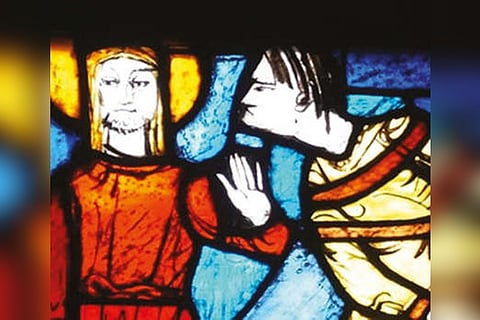

Weil der Stadt is a town of about 20,000 people in southwestern Germany, west of Stuttgart. At the Catholic church of St. Peter and Paul, pastor Anton Gruber has been welcoming his congregation as well as many curious visitors for the past 11 years. Some people stop by the church because it is right on a bike path, while others have come to peer at one stained-glass window. They often say “the features of Hitler are recognisable,” Gruber said. “People are simply curious, no more and no less,” the clergyman says about the pane that dates from 1939/40.
It is part of a larger window of nine panels depicting scenes from the life of Jesus. The pane on the far upper right depicts temptation, with the devil testing Jesus’ faith — and the artist JoKarl Huber has clearly given Hitler’s facial features to his depiction of the devil. The devil’s outfit is yellow, a color that stands for envy and possession. Most visitors have no problem understanding and contextualising the depiction of the dictator as evil personified, Gruber says, adding that the artist never commented on his work, so one can only assume that he wanted to portray Hitler as a figure of evil. The artwork was created in 1939, at the height of the Nazi regime.
Knowing the artist’s story helps understand the imagery, Gruber argues. “In 1936, the Nazis labelled JoKarl Huber’s art as ‘degenerate,’ and he was no longer allowed to work,” he says. St. Peter and Paul’s priest at the time, August Uhl, granted the artist asylum, along with a commission for renovation. Uhl’s sermons tended to be in opposition to the Nazis, which is why the Gestapo allegedly often showed up at his home, Gruber says. There is no doubt “the stained glass window represents an unequivocal and courageous statement against National Socialism and its leaders,” German historian Michael Kuderna told DW. His most recent book is about Hitler images in churches. In the course of his research, he found five images of Hitler that predate 1945 and nine that date to after 1945. With the early images, it can be difficult to prove they really show the dictator, but the later images clearly show Hitler, for instance as an executioner, or a villain burning in hell.
“After the war, depicting Hitler in churches was no longer as problematic as before 1945, when people feared retribution,” the historian explains. As time passed, the imagery changed: “Hitler was increasingly shown in other contexts, treated in a more distanced way, even to the point of caricature,” Kuderna adds. His research started 20 years ago at the church in Vasperviller. Created after 1945, a stained-glass window shows a biblical story from the Old Testament: Rachel, Laban’s daughter, steals her father’s household idols. The artist, Gabriele Kütemeyer, gave one of the idols Hitler’s face.
“The artist’s father was a staunch opponent of the Nazis; he was in Gestapo custody in Berlin for a time,” Kuderna explains, adding that the artist often heard her father say the Germans followed false idols. “That gave her the idea to look for that connection in the artwork.” Among the 14 illustrations Kuderna identified as clearly depicting Hitler, one of them — showing Hitler with Paul von Hindenburg, the German president who played a key role in the Nazi seizure of power — was removed after 1945. The historian points out that right after war, “people didn’t like to talk about these things, they felt embarrassed.” As a result, some of the images were hidden away while others were vandalised. Clearly, such images should not be hidden, or removed, Kuderna argues— they can serve as a basis to deal with the past. “Even if it’s difficult, because to this day, there is a lot that we haven’t processed.”
This article was provided by Deutsche Welle
Visit news.dtnext.in to explore our interactive epaper!
Download the DT Next app for more exciting features!
Click here for iOS
Click here for Android